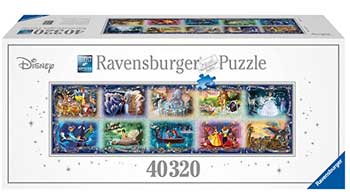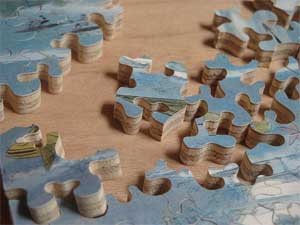The History of Jigsaw Puzzles
Jigsaw puzzles have captivated the minds and hearts of people for centuries, offering a unique blend of relaxation, challenge, and satisfaction. Assembling small, oddly-shaped interlocking pieces to create a complete image provides a sense of accomplishment, making it a popular pastime across generations.

This article delves into the rich history of jigsaw puzzles, examining their origins, historical significance, and evolution through time. We will explore the societal impact of jigsaw puzzles, their role in education, and their presence in popular culture. We will also discuss the stories behind some of the most famous puzzles, the rise of puzzles as a social activity, and their therapeutic benefits.
From the 18th-century beginnings to the present day and beyond, this article offers a comprehensive look at the fascinating world of jigsaw puzzles and their enduring appeal.
I. Historical Significance of Jigsaw Puzzles
How Jigsaw Puzzles Impacted Society
Puzzles have played a significant role in shaping society since their inception. Initially, they were a novel form of entertainment, providing a leisurely activity for people to engage in during their free time. As puzzles gained popularity, they transcended social classes, appealing to both the elite and the working class. This democratization of leisure was a crucial aspect of the evolution of modern society, fostering the growth of a shared cultural experience.

The popularity of Jigsaw Puzzles
The appeal of puzzles can be attributed to the unique challenge they present, requiring patience, problem-solving skills, and creativity. This versatile pastime attracted people of all ages, making it a popular choice for families and individuals alike. As a result, the puzzle market flourished, with numerous manufacturers and retailers emerging to meet the increasing demand. This growth in popularity also led to the development of more complex and intricate puzzle designs, as well as the expansion of subject matter to include various themes and interests.
The Role of Jigsaw Puzzles in Education
Jigsaw puzzles have long been recognized for their educational value, particularly in the development of critical thinking and spatial reasoning skills. In the 18th century, “dissected maps” were created to teach geography to children, offering a hands-on and interactive learning experience. As the educational potential of puzzles became more evident, they expanded to encompass various subjects, such as history, literature, and science. Today, puzzles continue to be utilized as an engaging and effective learning tool, both in formal educational settings and at home.
Jigsaw Puzzles in Popular Culture
The widespread popularity of jigsaw puzzles has led to their inclusion in various aspects of popular culture. They have been featured in books, movies, and television shows, often as a means to convey themes of mystery, perseverance, and teamwork. Puzzles have inspired artists and designers, leading to the creation of unique and imaginative works of art. Some puzzles have even become collector’s items, valued for their rarity or the significance of the images they depict.

Throughout history, several jigsaw puzzles have captured the public’s imagination due to their distinctive designs or fascinating backstories. One such example is the Ravensburger’s Memorable Disney Moments Puzzle, the world’s largest commercially available Disney puzzle. This 40,320-piece jigsaw depicts classic scenes from iconic Disney films such as Snow White, Cinderella, The Lion King, and more. When assembled, it measures 22.3 feet long and 6.2 feet tall, and each scene is beautifully illustrated to capture the magic of Disney.
The Therapeutic Benefits of Jigsaw Puzzles
In addition to their recreational and educational value, puzzles have been recognized for their therapeutic benefits. Engaging in this activity has been found to reduce stress and anxiety, as it requires focus and concentration, allowing individuals to momentarily escape their worries. Jigsaw puzzles also promote mindfulness and cognitive stimulation, helping to maintain mental sharpness and overall well-being. For these reasons, puzzles have become a popular component of various therapeutic interventions, including occupational therapy and dementia care.
II. The Origin of Jigsaw Puzzles: 18th-Century Beginnings
Chronological History of Jigsaw Puzzles
| Year | Major Event |
|---|---|
| 1760s | First known jigsaw puzzles created, known as “dissected maps” |
| 1800-1850s | Expansion of jigsaw puzzles to other subjects and themes |
| 1850s | Introduction of fretsaws, leading to more intricate puzzle designs |
| Late 1800s | Golden Age of Jigsaw Puzzles |
| Early 1900s | Boom in jigsaw puzzle popularity, due to mass production and improved technology |
| 1920s-1930s | Puzzle clubs and events become popular |
| 1930s | Jigsaw puzzles used as marketing tools during the Great Depression |
| Mid-1900s | Decline in popularity due to competition from television and other entertainment |
| Late 1900s | Resurgence in jigsaw puzzle popularity and innovations in manufacturing |
| 2000s | Emergence of custom and photo puzzles, online jigsaw puzzles |
| 2010s-2020s | Focus on sustainability and eco-friendly production, rise of artisanal puzzles |
| 2020-2022 | Increase in popularity of puzzles during the Covid-19 pandemic |
| Present | Integration of technology, such as augmented reality and interactive puzzle apps |

The First Jigsaw Puzzles
The origin of jigsaw puzzles can be traced back to the 18th century when European cartographers began creating “dissected maps” for educational purposes. These maps were made by mounting a printed map on a wooden board and then cutting it into small, irregular pieces. The intention was to provide a hands-on way for children to learn geography by reassembling the pieces.
Who Invented the Jigsaw Puzzle
The invention of the jigsaw puzzle is often attributed to English cartographer John Spilsbury. In the 1760s, Spilsbury recognized the potential for cut-up maps as educational tools and began producing them for sale. His innovative idea of creating a children’s puzzle from a map marked the birth of the modern puzzle.
How the Jigsaw Puzzle Got Its Name
Interestingly, the term “jigsaw puzzle” was not coined until the 19th century, long after their invention. The name comes from the “jigsaw,” a specialized saw with a narrow blade used for cutting intricate shapes in wood. Although the first puzzles were not made using a jigsaw, the term became synonymous with these puzzles as later craftsmen began using jigsaws to create increasingly complex designs.
Early Jigsaw Puzzle Makers and Designs
Following Spilsbury’s success, other craftsmen and mapmakers started producing their own puzzles. Early designs primarily focused on maps, but they soon expanded to include other educational subjects such as historical events, literature, and biblical scenes. These early puzzles were typically hand-cut from wood, making them expensive and limited to affluent families who could afford them.
Early Materials Used
The first puzzles were made using a variety of materials, with the most common being wood. Early puzzle makers would mount prints or maps onto wooden boards, often using materials like mahogany or cedar, known for their durability and fine grain. These wooden puzzles were then hand-cut using a variety of tools, including knives and later, fretsaws.
Evolution of Puzzles in the 18th Century
During the 18th century, as jigsaw puzzles gained popularity, their designs, production methods, and subject matter evolved. Puzzle makers experimented with various cutting techniques and materials to craft intricate and engaging puzzles, expanding beyond educational themes to encompass a wide range of artistic, cultural, and intellectual interests.
As puzzles began to explore diverse subjects, including historical events, literature, and scientific concepts, their educational potential was further realized, solidifying their role in education and contributing to their growing popularity.
III. 19th Century Developments
Golden Age of Jigsaw Puzzles
The 19th century marked the beginning of the golden age of jigsaw puzzles. As their popularity continued to grow, puzzles became more widely accessible, and their production methods evolved to meet the increasing demand. The introduction of new cutting tools and techniques allowed for greater complexity and intricacy in puzzle designs, fueling the public’s fascination with this pastime.

Introduction of Fretsaws
One of the most significant advancements in jigsaw puzzle production during the 19th century was the introduction of the fretsaw. This specialized cutting tool, which featured a narrow blade and a long frame, allowed for more precise and detailed cuts in the wooden pieces. As a result, puzzles became increasingly complex, featuring intricate designs that appealed to a wider audience.
Technological Advancements and Their Impact on Puzzle Production
Several technological advancements took place in the 19th century that greatly impacted jigsaw puzzle production. Innovations in printing technology enabled the creation of more detailed and colorful images, which were then used in puzzle designs. Additionally, steam-powered scroll saws were introduced, allowing for faster and more efficient cutting of puzzle pieces. These technological advancements made puzzles more affordable, leading to their widespread availability and popularity.
Puzzle Innovations
As the golden age of jigsaw puzzles progressed, manufacturers sought to create innovative and engaging designs to capture the public’s interest. One such innovation was the introduction of “interlocking” puzzle pieces, which fit together snugly and stayed in place without the need for additional support. This innovation allowed for larger and more stable puzzles, making them even more appealing to enthusiasts.

Other innovations included the development of “double-sided” puzzles, which featured a different image on each side, and “whimsy” pieces, which were designed in unique shapes, such as animals or symbols. These whimsy pieces added an extra layer of challenge and excitement to puzzle-solving, as they were often placed in unexpected locations within the puzzle. See: What is a whimsy piece?
The 19th century witnessed the emergence of puzzle series, which consisted of several puzzles that, when completed, formed a larger picture or told a story. These series not only provided a new level of challenge for puzzle enthusiasts but also encouraged collectors to purchase and complete the entire set.
Overall, the 19th century was a period of significant growth and innovation for the jigsaw puzzle industry. Technological advancements, coupled with the introduction of new cutting tools and creative puzzle designs, propelled jigsaw puzzles into the mainstream and solidified their status as a beloved and enduring pastime.
IV. Early 20th Century Popularity
The early 20th century experienced a boom in the popularity of jigsaw puzzles, with several factors contributing to their widespread appeal. First, improvements in printing technology enabled the production of puzzles with more vivid and intricate images. This attracted a broader audience, as puzzles began to feature a wide range of subject matter, catering to various interests.

Second, the introduction of die-cut cardboard puzzles made them more affordable and accessible to the general public. These mass-produced puzzles were cheaper to produce than their wooden counterparts, allowing more people to enjoy this engaging pastime.
Lastly, the rise of department stores and mail-order catalogs provided a new avenue for puzzle manufacturers to reach customers. This increased availability, coupled with the affordable pricing of cardboard puzzles, further fueled the growth of the jigsaw puzzle market.
Puzzle Clubs and Events
As jigsaw puzzles gained popularity in the early 20th century, they became an increasingly social activity. Puzzle clubs and events began to emerge, providing enthusiasts with a space to gather, share their passion, and collaborate on solving puzzles. These events not only brought people together but also fostered a sense of community and friendly competition.
Some establishments even organized “puzzle races,” where teams competed to complete a puzzle in the shortest amount of time. This added a new dimension to puzzle-solving, as participants not only had to work together but also strategize and communicate effectively to achieve their goal.
The Great Depression
During the Great Depression, jigsaw puzzles experienced a surge in popularity, as they provided an affordable form of entertainment for people struggling financially. Many individuals found solace in the act of puzzle-solving, as it allowed them to escape from the harsh realities of the time and focus on a task that was both engaging and rewarding.

Companies also recognized the potential of jigsaw puzzles as a marketing tool during this period. They began producing puzzles featuring their products or advertisements, which were then given away for free or at a low cost. This clever marketing strategy not only helped promote their brands but also provided a source of entertainment for the public during a time of great economic hardship.
The early 20th century marked a pivotal time in the jigsaw puzzle history, as they transitioned from a niche pastime to a mainstream form of entertainment. The affordability and accessibility of puzzles, coupled with the sense of community fostered through clubs and events, solidified their status as a popular and enduring pastime.
V. Mid-20th Century Decline
The mid-20th century brought about a decline in the popularity of jigsaw puzzles, primarily due to the emergence of new forms of entertainment. The advent of television, radio, and movies provided alternative leisure activities that captured the public’s attention. These new entertainment options offered instant gratification and passive enjoyment, making them highly appealing to the masses.
As more households acquired televisions and radios, the demand for jigsaw puzzles began to wane. This decline in popularity was further exacerbated by the increasing availability of other toys and games, which competed for consumers’ time and attention.
Impact on Jigsaw Puzzle Market
The decline in the popularity of jigsaw puzzles during the mid-20th century had a significant impact on the market. Many manufacturers and retailers struggled to maintain their businesses in the face of dwindling demand. Some companies were forced to close their doors, while others had to adapt and diversify their product offerings to survive.
Despite these challenges, a dedicated group of puzzle enthusiasts continued to support the industry, ensuring that jigsaw puzzles remained an enduring form of entertainment. These loyal fans, along with a few innovative manufacturers, helped to keep the puzzle market alive during this period of decline, laying the groundwork for the resurgence that would eventually follow.
VI. Late 20th Century Jigsaw Puzzle Resurgence
The late 20th century witnessed a resurgence in the popularity of jigsaw puzzles, as people began to rediscover the joy and satisfaction of puzzle-solving. Several factors contributed to this renewed interest, including nostalgia for a simpler time and a desire for activities that fostered relaxation and mindfulness.
Furthermore, the advent of the Internet allowed puzzle enthusiasts to connect with one another and share their passion for jigsaw puzzles. Online forums and communities provided a platform for people to discuss their favorite puzzles, share tips and tricks, and even trade or sell rare and collectible puzzles.

Innovations in Manufacturing
The resurgence of jigsaw puzzles was also fueled by innovations in manufacturing, which allowed for the creation of higher-quality, more engaging puzzles. Technological advancements in printing and cutting processes enabled the production of puzzles with sharper images and more intricate, precisely-cut pieces. This increased the appeal of jigsaw puzzles, as they not only provided a challenging activity but also produced a visually stunning end result.
In addition, the development of new materials, such as foam-backed and plastic puzzles, provided new options for puzzle enthusiasts. These materials offered unique characteristics, such as increased durability and resistance to wear, making them an appealing alternative to traditional cardboard and wooden puzzles.
The late 20th century marked an important turning point in the history of jigsaw puzzles, as they made a triumphant return to the forefront of popular culture. Innovations in manufacturing, coupled with a renewed appreciation for the mental and emotional benefits of puzzle-solving, ensured that jigsaw puzzles remained an enduring and beloved pastime.
VII. The Modern Era of Jigsaw Puzzles
Pandemic Puzzle Popularity: How Covid-19 Reignited Our Love for Jigsaws

In early 2020, the Covid-19 pandemic caused people all over the world to stay at home in an effort to slow the spread of the virus. With this came a surge in the popularity of jigsaw puzzles as a way for people to pass the time.
Jigsaw puzzles provide a great way for people to stay entertained and relaxed while at home. The challenge of piecing together a puzzle can be both mentally stimulating and calming, as it gives the puzzler a sense of accomplishment and progress.
Furthermore, many people have found that the act of putting together a jigsaw puzzle can be a great way to take their minds off of the stress and uncertainty brought on by the pandemic. The focus, attention, and concentration required to put together a puzzle provide a welcome distraction from the events of the day, allowing puzzlers to take a break from the news and relax.
The Covid-19 pandemic caused a resurgence in the popularity of jigsaw puzzles as a way for people to stay entertained and relaxed while at home. The challenge, sense of accomplishment, and ability to connect with others have made jigsaw puzzles an excellent way to pass the time during this difficult period.
Impact of Technology on Jigsaw Puzzles
Technology has played a significant role in shaping the modern era of jigsaw puzzles, offering new and innovative ways for people to enjoy this timeless pastime. One notable development is the emergence of online jigsaw puzzles, which allow users to solve puzzles on their computers or mobile devices. These digital puzzles offer a convenient and accessible alternative to traditional physical puzzles, making it easy for people to engage in puzzle-solving anytime, anywhere.
The Emergence of Custom and Photo Puzzles

Another important innovation in the modern era of jigsaw puzzles is the rise of custom and photo puzzles. Advances in digital printing technology have made it possible for consumers to create personalized puzzles featuring their own photographs or artwork. This has added a new dimension to the puzzle-solving experience, as people can now assemble images that hold personal meaning and sentimental value.
Online Jigsaw Puzzles
The Internet has also played a key role in the modern era of jigsaw puzzles, providing a platform for enthusiasts to connect, share, and explore new puzzle-solving experiences. Online jigsaw puzzles offer users the ability to choose from a vast library of images, adjust the number of pieces and difficulty levels, and even save their progress to continue at a later time. This digital evolution has made puzzle-solving more accessible and appealing to a wider audience, ensuring that jigsaw puzzles remain a popular and enduring pastime.

Artisanal and Custom Puzzles
The modern era has seen a resurgence in artisanal and custom puzzles, with many small businesses and independent artists creating unique, handcrafted designs. These puzzles often feature intricate artwork, high-quality materials, and innovative cutting techniques, making them highly sought-after by collectors and enthusiasts alike.
The growing popularity of artisanal and custom puzzles reflects a broader trend toward personalized and high-quality products that cater to individual tastes and preferences.
Overall, the modern era of jigsaw puzzles is characterized by innovation, personalization, and a commitment to sustainability. As technology continues to advance and consumer preferences evolve, it is clear that jigsaw puzzles will continue to adapt and thrive, remaining a beloved and enduring pastime for generations to come.
What the Future Holds…
In today’s ever-changing landscape, jigsaw puzzles continue to evolve, adapting to technological advancements and consumer preferences. The growing popularity of artisanal and custom puzzles demonstrates the desire for unique, high-quality products tailored to individual interests.
Furthermore, the increasing demand for sustainable puzzle production has led manufacturers to adopt eco-friendly materials and packaging, ensuring that puzzles remain relevant and appealing to environmentally-conscious consumers.
The future of jigsaw puzzles is set to be exciting and dynamic, with innovative technologies, materials, and production practices shaping the industry in sustainable ways.
As puzzles continue to adapt and evolve, they will maintain their status as a popular and enduring pastime. This guarantees that puzzle enthusiasts around the world can enjoy both traditional and cutting-edge puzzle-solving experiences for years to come.

Founder and owner of TSG Products Inc., the Canadian company behind PuzzlesUnlimited.com and Jigsaw2order.com, one of the web’s oldest sites offering personalized, custom-made jigsaw puzzles since 2002.
With over 2 million puzzles manufactured and collaborations with thousands of artists, photographers, museums, and corporations, Colin’s expertise in the puzzle industry is unparalleled. His company, TSG Products Inc., is dedicated to producing high-quality jigsaw puzzles for customers worldwide, providing unique and creative products for the global market.
